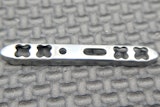Let’s face it, most engineers have the “inventor” gene and an idea for their version of a great new product. Some actually patent and prototype that idea, and successfully market that product. One of the barriers that used to keep those numbers low was difficulty in finding financial backing and marketing the product. Open source hardware only puts traditional funding further from reach, as investors typically want to see ownership of the IP.
With crowd-funding websites like www.kickstarter.com, the DIY market has much easier access to a promotional platform to raise funding and begin building a market. Participants in Kickstarter, and similar sites, aren’t investors, so there’s no approval “committee” to face. Projects are judged on their merits, and the possible rewards, by the market. Not surprisingly, DIY ventures tend to be pretty lean and rely heavily on outsourced services, such as prototyping and volume manufacturing.
For example, last year when NTHSynth launched its first product, it used Kickstarter for funding and Screaming Circuits for prototypes and production units. NTHSynth is a collaboration between John Staskevich and Kevin Holland that develops fun, unique and intuitive products. The NTH Music Synthesizer met its funding goal on Kickstarter in March 2012 and was shipped in July of the same year. Electronics engineer/co-owner John Staskevich highlighted instant quoting and a very informative website and blog as the two most important things he valued at his prototype supplier.
“When I was new to purchasing electronics assembly, Screaming Circuits was the only assembly house I could find that published complete, explicit instructions for presenting a design for manufacture. They also have an informative blog that answered many of my printed circuit board (PCB) assembly questions. This made me very comfortable engaging them,” John said.
“Our supplier’s instant online quoting is a valuable tool because it helps us to anticipate project costs at a very early stage in the design process. It allows us to quickly calculate the costs of different production scenarios, helping us to set the appropriate Kickstarter funding threshold and reward pricing. With Kickstarter pre-sales and contract manufacturing, we can match production to demand and move on to our next design project without carrying inventory.”
NTHSynth launched its newest products, the Luminth, a minimalist USB control peripheral and the Luminth Orbiter, a generative music software application, on Kickstarter in May. More information on NTHSynth’s new products can be found at www.nthsynth.com.
As this example illustrates even with successful Kickstarter funding, DIYers need to look for as much value for each dollar they spend as possible. Here are a few tips for ensuring a smooth outsourcing process:
- Pick a partner who values your business – DIYers start small and typically have a very small team. There a plenty of contract manufacturers ready to help customers who have large production volumes, but many are less interested in small production quantities and/or start-up companies. Small job shops may be comfortable with small orders, but don’t always have extensive engineering resources. Visit prospective suppliers’ websites and call into their shops. Are there online resources that explain what you need to provide with your order? Is the team helpful or not interested in your project? Can you buy the services you need?
- Look for a pricing and business model aligned with your likely demand patterns. DIYers typically start with a prototype and then need small production runs. Do the contractor’s service offerings align with that? Is pricing easy to calculate? Make sure that the ultimate pricing isn’t dependent upon “how much have you got?” Some vendors will see your funds raised on Kickstarter and raise their prices accordingly. Others have fixed pricing that won’t go up if you have more money.
- Look for good DFM/DFT expertise –Your prototype supplier should be able to provide design for manufacturability/testability (DFM/DFT) guidelines or a helpline to assist with component footprints not in your CAD library, best layout options for odd form components or other resources that can be tapped to speed your internal layout efforts.
- Don’t be afraid to ask for ideas - The days of prototype suppliers simply building boards are long gone. Part of the service at most good prototype houses is helping organize and rationalize the product development process. Don’t be afraid to ask your prototype supplier for ways you can work with them more efficiently. Tap their engineers for ideas on better layout or component selection.
- Look for free online resources - Blogs, white papers, articles and design guidelines are just a few of the resources out there to help you avoid making time-consuming costly mistakes. Check your prototype supplier’s websites to see what free resources are offered in this area. Join open source communities and read, listen and contribute.
- Listen to advice - Good prototype and volume manufacturing houses don’t want to make money on your inefficiencies. If they identify ways you can save money and time by changing your process, take their advice. While changing your process may seem like added work you don’t have time for, setting up a robust partnering process with your prototype suppliers will make it easy for your company to grow as business grows.
- Align your documentation with your supplier’s preferred formatting - While there are a number of good systems out there that can “translate” your electronic files to desired outputs at the production house, the garbage in, garbage out rule still applies. Gaps in information take time to identify and correct. Understanding your supplier’s preferred documentation structure and content eliminates days of non-value-added follow-up activity. Consider some of the newer manufacturing file formats, like ODB++.
For more tips on translating your ideas into a manufacturable product, visit the Screaming Circuits blog at http://blog.screamingcircuits.com/























